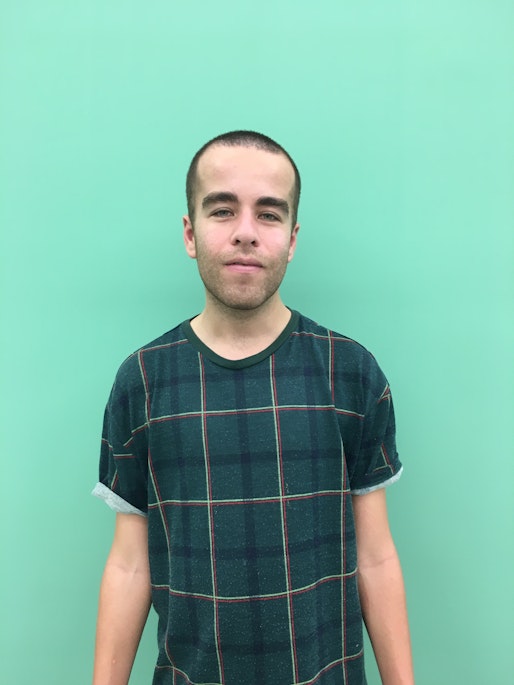Wansolwara Symposium
Robert Henningham
Presented in partnership with UNSW Galleries and 4A Centre for Contemporary Asian Art as part of Sydney Festival, Wansolwara Symposium, held 18 January 2020 at UNSW Galleries, drew together a range of diverse perspectives to reflect on the Great Ocean as a connector to culture, ancestral traditions and people.
As with the exhibition Wansolwara: One Salt Water, the symposium drew inspiration from the Solomon Islands pidgin word wansolwara, meaning ‘one salt water’ or ‘one ocean, one people’, and encapsulated the idea of a connected waterscape that holds within it distinct and diverse communities. Accordingly, the symposium demonstrated UNSW Galleries’ and 4A’s work to expand their engagements with the diverse and unique practices of Pacific cultures, drawing together a range of perspectives on the ocean as a connector to culture, ancestral traditions, and the movement of people and practice as a mode to decolonise, reclaim and celebrate the richness of both historical and contemporary Indigenous narratives.
Welcome to Country with Aunty Maxine Ryan and Introduction from José Da Silva, UNSW Galleries Director
Aunty Maxine Ryan from the La Perouse Local Aboriginal Land Council opened the day with a Welcome to Country, noting she came from the Dharawal people and acknowledging the Bidjigal and Gadigal people, on whose lands UNSW Galleries sits. Ryan reflected on the local area and how her people have continued to maintain their connection to country, citing ‘the unofficial camps of the 1800s, ceremonial grounds of army barracks, or the [their] gainful employment.’ UNSW Galleries Director José Da Silva followed with a brief Acknowledgement of Country and noted the gallery’s surrounding areas, including nearby sections of Oxford Street, Centennial Park and Rushcutters Bay, as a network of pathways, creeks and valleys that held significance in the lives of the people of the Eora Nation, before acknowledging the exhibition Wansolwara. Da Silva quoted from Wansolwara co-curator 4A Director Mikala Tai who, in conceiving the ideas behind the project, considered that rather than a force of separation, ‘the ocean was respected as a great connector and a dynamic living force’, unrestricted by borders or divisions, acting as ‘a nexus of connection’, providing varying frameworks for complex thinking about the multifaceted practices and knowledge systems from Pacific First Nations peoples in a global context. Da Silva’s opening remarks sought to speak to each of the artists displayed in the gallery while acknowledging the range of curators and creatives behind the project and how the collaborative nature of Wansolwara aimed to expand ideas that re-frame concepts of the Pacific as not just a singular outlier of geography, but as a new network of exchange and ideas that goes beyond typical Eurocentric mediums of scholarly art thinking.
Talia Smith, Shivanjani Lal and Salote Tawale in conversation
The first conversation of the day was shared by curator and artist Talia Smith, artist Shivanjani Lal (exhibiting in the solo showing Shivanjani Lal: Beta, ek story bathao as part of Wansolwara at UNSW Galleries) and artist Salote Tawale. They considered the enduring effects of displacement for diasporic communities as a result of histories of indentured labour, migration and ongoing colonial forces. Each of the speakers expressed a determination to share and reclaim the narratives, customs and traditions of the Pacific Islands, while sharing their own unique perspectives of contemporary Pacific diaspora through their practice and their authoring of the experience.
Talia Smith began her presentation with an Acknowledgment of Country, and extended respects to the Tāmaki Makaurau peoples of her traditional homeland in Aotearoa New Zealand and her ancestors in Sāmoa and The Cook Islands. Smith shared an edited version of her curatorial project, previously presented at The Ballarat Curatorial Forum, starting with an anecdote about her grandparents, who inform large parts of her curatorial work. Smith referenced their assimilation from Sāmoa and The Cook Islands into New Zealand and the generational ramifications of lost familial sharing of language and cultural tradition. This personal premise, alongside the erasure of broader Islander tradition and contemporary stories in the profusion of White photography within art history, forms the basis for Smith’s curatorial projects, including her ongoing research project More than all the ocean between us, shown as an Ideas Platform exhibition at ArtSpace, Sydney, in 2019. A multilayered project, it sought to encourage more ‘making’ from emerging Pacific Island artists and investigate how these artists use time-based practices to highlight the diaspora experience while creating a more extensive archive of Pacific artists to challenge a Western history of photography. Beyond this project, Smith reflected on the work of three photographers—Edith Amituanai, Sione Monu and Louisa Afoa—and how their visual mediums are employed to re-author stories, explore ‘how we bring contemporary Pacific experience into traditional ideas’, and the influences of globalisation on Pacific culture, the body and consumerism. While each of the practices of these artists is varied and unique, Smith brought them together as clear examples of contemporary Pacific artists using their practice to own Pacific histories, stories and their contemporary experiences.
Shivanjani Lal spoke next to the concepts and ideas behind her practice and her works on display as part of Wansolwara. Lal began by acknowledging archival imagery and found materials as a key component of her practice. She recognised both the gifts of imagery in telling stories and the challenges invoked when not having ‘access to the stories’ behind each of them. Lal spoke to her photographic works in Wansolwara as a means of exploring her family histories before indentured labour brought them from India to Fiji. She recalled her return to Fiji after many years away studying indentured labour histories in India and how ‘the languages of that place had changed’, as had individual words. Her grandmother’s farm had become a plantation and farmers were no longer farmers but girmitiyas, or slaves. In reference to her uncle’s stories of working in the sugar-cane industry, which was founded on slavery, Lal recognised the significance of familial exchange in the passing of critical intergenerational knowledge and family history, and pondered, ‘in the use of older images am I thinking about what happens now?’ These questions continued to be explored in the symposium in various conversations.
Salote Tawale began her talk acknowledging ‘presence, absence, intimacy, here and there, now and then’ as the major directives in how she works with her subject matter and as using ‘experiential prompts to shape and direct’ the way she works as a maker, and how that influences experiences for viewers of her work. Immediately, Tawale acknowledged that among a hierarchy of audiences, first and foremost her audience is Pacific diaspora, and in keeping these audiences in mind while making, viewers from the diaspora are more likely to understand the works. She noted how within her practice she draws from her experiences of growing up in the diaspora, pulling from the ‘disparate parts’ of her existence and histories to bring together artworks where there is ‘a lot of material up for grabs’. Tawale also referred to her participation in a residency for Sydney Festival’s The Future is Floating: Pacific (2020) and to the ideas that arrived from Marianne Nicholson: that by making works and putting them into the world ‘there is the sense of hope within us’, because they have been put out for consideration and discussion and that challenges colonial histories and the legacies of ‘living in colonised bodies’.
Smith began an exchange between the three speakers by noting that she thought Tawale’s recent works Mooning you, from a series of works roughly titled A park is not a forest, really spoke to questions about ‘what is a good person of colour and what’s a bad person of colour?’ The conversation explored further ideas of diaspora, with Smith referring to the diasporic ideas explored in Lal’s works and the mixed feelings of identity that come from growing up with diasporic identity and away from ‘ancestral homelands’. She noted that while carrying contrasting feelings of both connection and disconnection, ‘especially for those who haven’t grown up with tradition or language’, there is always the difficulty of not feeling good enough. There is the recurring question of ‘What is a good example of a Pacific Islander and what is a bad example?’, and how people find themselves fitting in on that scale. The conversation moved towards the use of photography and its function of connection to the past and present. Lal noted that part of her reasoning behind taking new photographs is because ‘something is happening right now’; that looking back into the past can limit what you can see in the present, and that there is ‘something about capturing or distilling that moment of time.’ Smith echoed this sentiment, suggesting an inherent part of photography is how it ‘captures a moment, but that you will never be able to capture that moment again, the feelings, the history’, and that it will always be different for each person who comes across it.
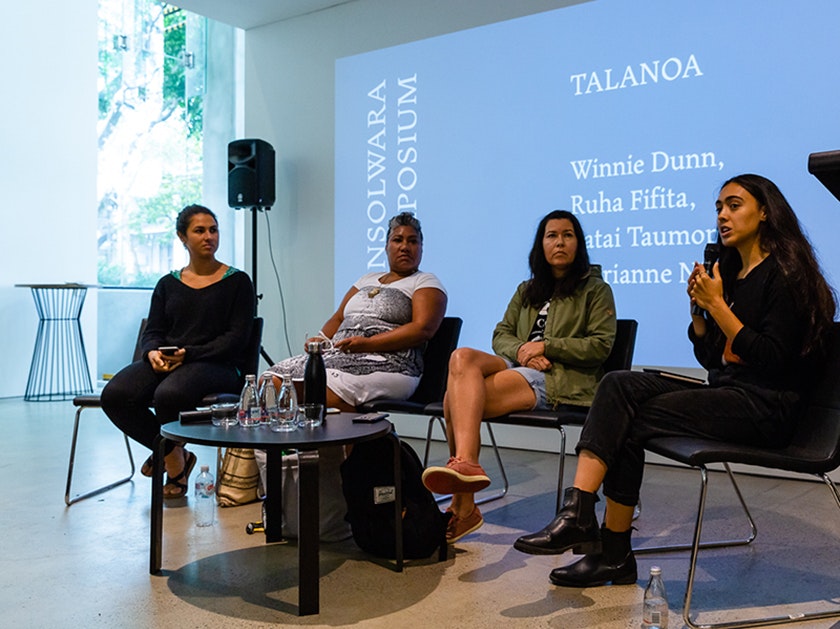
Wansolwara Symposium Talanoa, left to right: Ruha Fifita, Latai Taumoepeau, Marianne Nicolson and Winnie Dunn, 18 January, UNSW Galleries; photo: Document Photography, courtesy UNSW Galleries.
While carrying contrasting feelings of both connection and disconnection, ‘especially for those who haven’t grown up with tradition or language’, there is always the difficulty of not feeling good enough.
TALANOA: An intercultural dialogue with Winnie Dunn, exhibiting artists Ruha Fifita, Latai Taumoepeau and Marianne Nicolson, visiting Musgamakw Dzawada’enuxw First Nations artist activist
The second presentation in the program brought together a talanoa, a term used across the Pacific to consider processes of transparent, inclusive and participatory dialogues. Winnie Dunn began by taking a moment to emphasise the importance of fostering deep dialogue and speaking with respect with and through one another within customary talanoa. The panellists discussed the function of art as a site of engagement, activism and advocacy. In the context of the catastrophic summer bushfires, there was a focus on the importance of connection to the land and Indigenous understandings, knowledge and practice of caring for the land.
Each of the artists spoke to the ideas of wansolwara, referencing the integral part that water plays in their own cultural foundations and its symbolism as a connector. They went on to discuss how their artworks are used as a means of activism in their resistance to colonisation, and regularly referenced the visible environmental destruction of native lands. Marianne Nicolson spoke of how in her culture cardinal directions of North, South, East and West do not exist, and that her community’s primary orientation is through the body’s direction towards either the ocean or forest. She spoke of how her practice has been motivated ‘by wanting to express the beauty of our way of life and our way of being in the world as Kwakwaka’wakw people’, while simultaneously resisting destruction and attempts ‘to crush the life’ out of her communities and to assimilate into Eurocentric society. Nicolson expanded on these ideas, suggesting her practice was a balancing act between celebrating the vibrancy of Kwakwaka’wakw cultural heritage while creating work that would show the damages of both historical and ongoing colonisation and ‘how we deal with what is happening to our lands’.
Ruha Fifita reflected on the ocean as a ‘powerful fathomless’ connector, as a site of knowledge and navigation for Pacific peoples whose understandings could be shared and used to regain consciousness of and appreciation for the environment. Her work in the UNSW Galleries space can be seen as particularly tied to this. Titled Lototō (2016)—a Tongan word suggestive of values of generosity, humility and of our interactions with the natural environment—the work uses pigments from the islands of Vava’u, Tonga, and Ile Oue (Ouen Isle), New Caledonia, and is based on the legends, stories and songs connected to the migration of whales. Fifita also spoke to Dunn’s remarks on the significance of blending ‘traditional’ artforms with ‘Western’ artforms, suggesting that in her practice it was important to approach the past with an inquisitiveness that asks about ‘the why and the purpose’. When considering approaches to new technologies and new media it was important to be cautious of the ‘convenience’ and ‘immediacy’ and to reflect on their actual value and purpose. She referred to her work with ngatu (painted bark-cloth tapestry) and suggested that while there have been many changes to methods and technologies in the making of ngatu, it was necessary to think about why these changes are made and to understand what could be lost, how changes could affect the quality and longevity of works, and also ‘how cultural spirit is kept’.
Latai Taumoepeau noted the significance of collectivism in her work as a performing artist and her focus on ‘place’ in her making. She referenced her endurance work Repatriate, a 2015 video work first presented as part of 24 Frames Per Second at Carriageworks and later re-performed in 2018 as part of Perth Festival, which explores the effects of climate change on the Pacific through dance, flotation devices and a tank of rising water. ‘The body is used as a metaphor for land’ as it becomes a struggle to hold onto the culture and choreography that is embedded in the movement of dance. The formula behind this, Taumoepeau added, was important Indigenous cultural heritage acting as a continuum within the context of a contemporary work. Latai noted that ‘the form’ in art-making is political and that having trained in both the Western art context alongside her own cultural modes of performance, there ‘are ways to centre indigeneity in practice where it is not about being “traditional” but a continuum of that culture.’
Winnie Dunn finished the conversation by reflecting on the importance of cross-Indigenous dialogues in art. Taumoepeau emphasised that she was a strong believer that ‘the future is Indigenous’ and that this was particularly significant now, as environmental catastrophe increases. Marianne Nicolson spoke of the challenges in resisting assimilation in the context of her Canadian communities, but also of the hopefulness of dialogue when Indigenous people come together, the need for artistic voices in resistance to the ongoing environmental sufferings of the land, and ‘artistic expression as a validation’ of Indigenous activism among communities from across the globe. Fifita expanded on these ideas, suggesting that now, more than ever, as environmental degradation and damage to homelands worsens, significant elements of Talanoa, including that of ‘collaboration and progress of spirit’, become critical, with Indigenous discussions playing a crucial role in helping people learn how to listen and see the world through many perspectives.
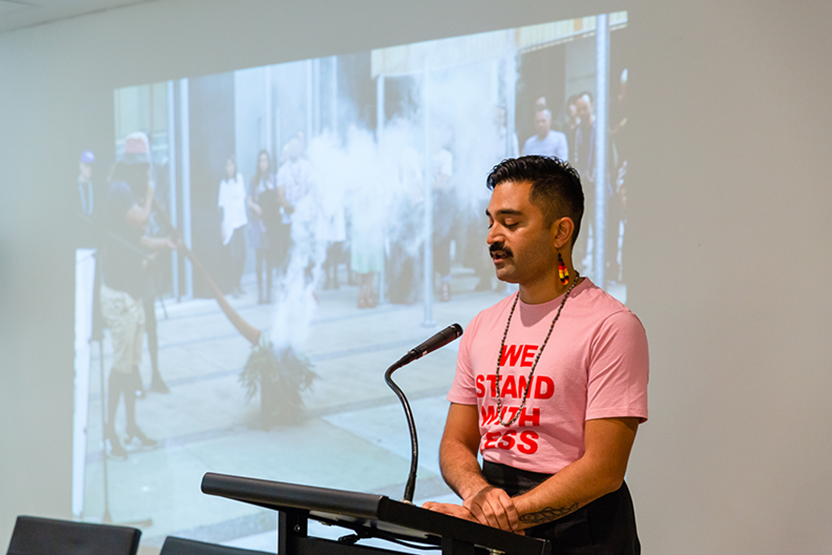
Wansolwara Symposium, Keynote: ‘Indigenous artist-curator relationships in the militourist present’, Dr Léuli Eshrāghi, 18 January, UNSW Galleries, Image: Document Photography, courtesy UNSW Galleries.
KEYNOTE: ‘Indigenous artist-curator relationships in the militourist present’ by Dr Léuli Eshrāghi with response by Indigenous Pacific Studies scholar Mitiana Arbon
The symposium’s third presentation was the keynote address by Dr Léuli Eshrāghi, curator of the UNSW Galleries exhibition O le ūa na fua mai Manuʻa, part of the Wansolwara project. Titled ‘Indigenous artist-curator relationships in the militourist present’, Eshrāghi’s talk began with an Acknowledgement to Country in both English and Sāmoan. Eshrāghi began the address recognising the Great Ocean and knowledge of Indigenous peoples as ever present and defiant of ‘colonial capitalism’s climate apocalypse’. Eshrāghi reflected on curatorial practice as ‘anchored in considering Indigenous ways of being, organising, loving, world-making and caring that predates and will post-date Euro-American norms and knowledges’, and cited academic Teresia Teaiwa’s definition of ‘militourism’ as ‘the phenomena by which military or a paramilitary force ensures the smooth running of the tourist industry and that same tourist industry is masked by military force behind it.’
Eshrāghi spoke of work on an 18-month-long project through the Institute of Modern Art (IMA) in Brisbane which included three iterations: The Commute (2018) at IMA, Layover (2019) at Artspace Aotearoa, Auckland, and Transits and Returns ( 2020) at Vancouver Art Gallery. Working alongside four other Indigenous curators, Eshrāghi created an artist-centred project that sought to see local and international Indigenous peers enjoying ‘much improved conditions for production, exhibitions, scholarship and dissemination of contemporary art practice.’ The project’s participants took in Indigenous curatorial collective gatherings in Whitehorse, Northern Canada, and Brisbane, and art residencies in Auckland and Banff. Stemming from the project and the new relationships that were formed as a result, Eshrāghi spoke of a linguistic-based work co-authored with Sébastien Aubin titled Punāʻoa o ʻupu mai ʻo atumotu/Glossaire des archipels (2019); a poster that acts as a multilingual guide in Sāmoan, French and English to ‘represent currents of thought and action in international Indigenous visual cultures.’ Inspired in part as a means to ‘find glossaries not written by colonisers’, Eshrāghi emphasised the significance of the work in thinking through the ‘demoting of the coloniality of knowledge’ and the importance of enabling Indigenous ‘words, concepts, values and languages’ to survive and not be defined by European histories.
After discussing past projects and his curatorial practice, Eshrāghi pointed to the Westernised colonial ‘nefarious settler entitlement of Australian universities’ and the challenges within the academic realm that continue to threaten autonomous spaces and learning for Indigenous curating, research and art making. Eshrāghi pondered why it was so hard for universities to facilitate Indigenous support staff in diverse roles. Even in Western linearity, Eshrāghi suggested, the future should be informed by the past. The interruption of Indigenous systems of knowledge and art practices, it was suggested, is a reflection of the unwillingness of art schools, galleries, archives, libraries, and museums to fulfill the promise of conciliation and reconciliation where Indigenous ‘artforms are centred and informed by a strong territorial-based core.’ However, while questioning this interruption, Eshrāghi emphasised the strength of Indigenous creative expressions and shared knowledges, particularly within the Great Ocean, and the importance of its energy and the power of its life-force as being shared among close kinship within ‘all living things’.
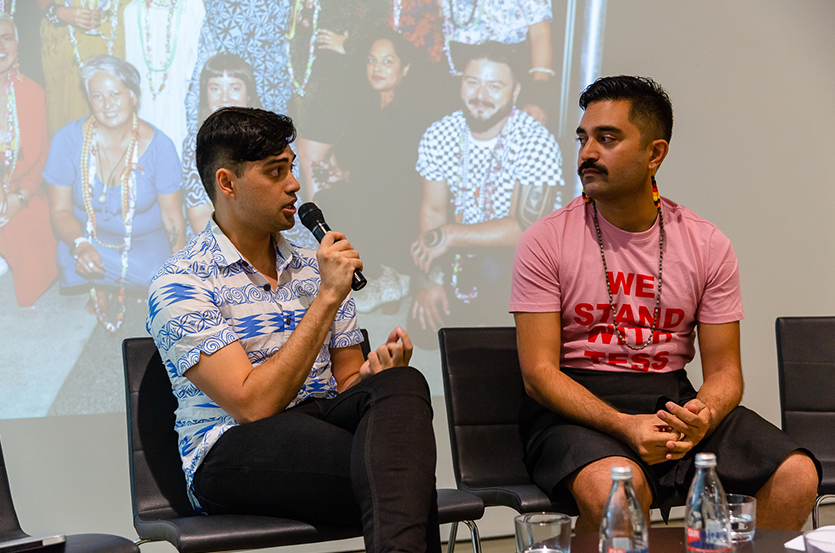
Wansolwara Symposium, Keynote: ‘Indigenous artist-curator relationships in the militourist present’, response by Mitiana Arbon (left) Dr Léuli Eshrāghi (right), 18 January, UNSW Galleries, Image: Document Photography, courtesy UNSW Galleries.
Eshrāghi was then joined for a responsive conversation with Indigenous Pacific Studies scholar Mitiana Arbon. Arbon began the conversation by acknowledging the words of scholar Teresia Teaiwa, suggesting the criticality of ‘the need to resist all attempts to reduce our great Moana and its people into one single thing or issue and to remind people of its complexities’. Arbon then reflected on the Latin roots and shifting historical meanings behind ‘curator’. Breaking down the linguistics of the word, Arbon highlighted the significance of ‘curer’ in the word and its reference to medicinal or healing properties, its later adaptation by the church to refer to someone taking care of spiritual health for the community, and then more recently as a keeper and manager of collections. This small dissection was a particularly fitting way of understanding the relationship between curator and artist within Eshrāghi’s project work and presentation, and the power of both to work together in a manner that simultaneously ‘cures, cares and nourishes communities’. Arbon further reflected on these linguistic elements of ‘curator’ and how they applied to the propositions made in Eshrāghi’s presentation, comparing notions of ‘cure’ to the ideas explored by Eshrāghi and the emphasis on the importance of healing ‘the borders and bricks of European colonial positions’. It was argued that embracing the ‘relational ways of longing to the fluid expanse of the term wansolwara and of imagination, of islands connected by invisible bonds, kinship, imagination, shared languages, creative and migrational exchange’ are a major healing force behind the ongoing revival and survival of communities against a history of trauma and suffering brought by colonisation.
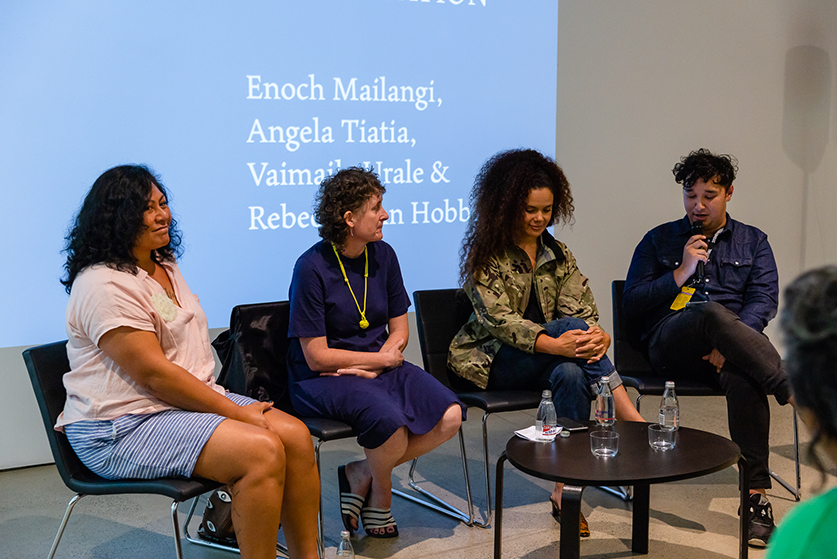
Wansolwara Symposium, Conversation, left to right: Vaimaila Urale, Rebecca Ann Hobbs, Angela Tiatia, Enoch Mailangi, 18 January, UNSW Galleries, Image: Document Photography, courtesy UNSW Galleries.
CONVERSATION: Enoch Mailangi, Angela Tiatia, Vaimaila Urale and Rebecca Ann Hobbs
The final conversation of the day was moderated by writer and text-based artist Enoch Mailangi who was joined by UNSW exhibiting artists Angela Tiatia and 4A exhibiting artists Vaimaila Urale and Rebecca Ann Hobbs for a conversation on the convergence of the traditional and contemporary in popular culture and the creation of new, hybrid phenomena. Mailangi prompted the conversation by comparing the internet to the deepness of the ocean, acknowledging the risks to First Nations people posed by internet content, while at the same time highlighting the capacity for the internet to be utilised as resistance in the form of humour and cheek. Mailangi spoke of the concept of ‘hybrid phenomena’ as a space in which a work, like a meme, is ‘very intentional and often operational as an outward gesture to movements and systems that sits between the binary of virtue signalling and signal boosting.’
Angela Tiatia said she agreed with earlier sentiments of the day expressed by Latai Taumoepeau, in preferring not to use the word ‘tradition’ when it comes to Pacific heritage arts and her own art making, in that it suggests there is no continuum to Pacific art making. Instead she emphasised ‘heritage’ in her approach to the conversation and how heritage can co-exist with contemporary ideas and new media. As the conversation developed, each artist spoke of their homelands, practice and rationale behind their exhibited work, dissecting how their work seeks to celebrate both heritage and contemporary cultures and use new media and the digital sphere as a way to subvert traditional colonial ideas. Hobbs spoke to how the internet allows contemporary performances of power, where violent colonial cultures are played with and subverted across memes, gifs, tik toks and vines. Urale spoke of her work Manamea ma Anivanuanua (2020), on show at 4A, and its referral to traditional Sāmoan symbolism through the universal language of keyboard characters in the form of forward, back and angled bracket key slashes. Grounded by tapa (bark cloth) and tatau (tattoo) practices, Urale’s work is sand-based yet distinctly contemporary in its references to everyday digital symbology. In her redeployment of these symbols, Urale demonstrates the convergence of the traditional and contemporary in popular culture.
About the contributor
Rob Henningham is an arts administrator and writer with experience across multiple disciplines.
